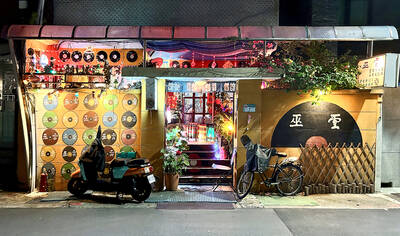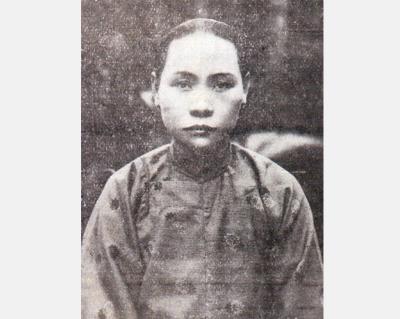The National Palace Museum Tea Ceremony Exhibition (故宮文創系列活動 — 茶事展演) is something new in the annals of this venerable museum. It is a novel departure on many fronts, not least as being the first time guests can partake of tea and snacks as an actual part of the overall experience of art appreciation.
The current exhibition is a pilot project for a cultural creativity center (創意中心) that has been much touted by the National Palace Museum’s recently installed director Chou Kung-shin (周功鑫). Speaking at the opening of the activity at the museum’s Second Exhibition Area in the Library Building (圖書文獻大樓), Chou said that the museum, as the most esteemed and sophisticated cultural conservation agency in the country, would be able to provide a solid basis for the development of Taiwan’s “creative cultural industry” (文化創意產業).
“In Taiwan, we have lots of creative talent, and industry is what we built this country on,” Chou said. “We can provide a foundation that will inject a richer cultural content into the efforts of our young creative artists and entrepreneurs.”
The move is part of a larger effort, which has already seen the establishment of highly successful musical evenings and the creation of a Children’s Gallery, to expand the museum’s role and interact more energetically with contemporary social and cultural developments.
For the current activity, the museum has commissioned the Ren Dan Ru Chu Tea Study Group (人澹如菊茶書院) to create an exhibition on the theme of tea, relating it to both the physical and spiritual environment of the tradition. While the museum’s collection contains many artifacts and paintings related to tea drinking, the current exhibition is housed in seven spaces created by interior designers working together with tea experts and members of the study group.
A CUP OF CALM
Interior designer and curator Chen Cheng-tao (陳正道), in explaining his own exhibit — a simple steel frame hut, the shadow of a tree falling against the wall, a low wooden table placed on a mat floor — said that the environmentally friendly nature of the materials he used, and even the shadow on the wall, were all part of an atmosphere that was integral to creating an environment for appreciating tea and the meditative calm that this activity can induce.
A new student of tea master Li Shu-yun (李曙韻) who was serving as an assistant at the event was effusive about the beauty of the spaces, saying they almost brought tears to her eyes.
The careful combination of materials, light and utensils are designed to suggest poetic atmospheres that stimulate the senses.
“In the workplace, you have to do many things that you might not want to, so you close down your awareness to things,” she said. “Tea appreciation helps you to open up your awareness again, as you focus on subtle things in the act of making and serving tea.”
Some of the spaces are traditionally decorated, ranging from re-creations of traditional Hakka architecture from Beipu (北埔) in Hsinchu County, to highly contemporary affairs, such as one enclosed in a giant transparent plastic bubble and another hung about with reflective strips of material.
SUP AND LEARN
There is plenty to think about in viewing the exhibition, and a free English-language pamphlet available at the door goes some way to explaining the concepts involved.
As with many contemporary art shows in Taiwan, the explanatory notes next to the exhibits, some in poetry form, are excessively abstract.
Volunteers will be on hand every day to answer questions, and there are lectures to be given by tea masters every Friday, Saturday and Sunday until April 18, on subjects such as The Aesthetics of Taiwan Tea Culture (台灣紅茶篇), the Potential of the Taiwanese Tea Room (台灣茶室的可能), and A History of the Changing Flavor of Prize-Winning Dongding Oolong Tea (凍頂比賽茶的變遷史).
A full schedule of the lectures is available on the museum’s Web site (Chinese only) at www.npm.gov.tw/zh-tw/learning/education/education_08.htm?docno=101. Seating for the lectures is limited and bookings are recommended. Call (02) 2881-2021 X2113 to make a reservation.
The Ren Dan Ru Chu Tea Study Group will provide tea and traditional tea snacks in the lobby outside the exhibition area for NT$100, giving visitors a chance to appreciate some tea after they have contemplated the artistry of the seven tea drinking areas.

The Lee (李) family migrated to Taiwan in trickles many decades ago. Born in Myanmar, they are ethnically Chinese and their first language is Yunnanese, from China’s Yunnan Province. Today, they run a cozy little restaurant in Taipei’s student stomping ground, near National Taiwan University (NTU), serving up a daily pre-selected menu that pays homage to their blended Yunnan-Burmese heritage, where lemongrass and curry leaves sit beside century egg and pickled woodear mushrooms. Wu Yun (巫雲) is more akin to a family home that has set up tables and chairs and welcomed strangers to cozy up and share a meal

Dec. 8 to Dec. 14 Chang-Lee Te-ho (張李德和) had her father’s words etched into stone as her personal motto: “Even as a woman, you should master at least one art.” She went on to excel in seven — classical poetry, lyrical poetry, calligraphy, painting, music, chess and embroidery — and was also a respected educator, charity organizer and provincial assemblywoman. Among her many monikers was “Poetry Mother” (詩媽). While her father Lee Chao-yuan’s (李昭元) phrasing reflected the social norms of the 1890s, it was relatively progressive for the time. He personally taught Chang-Lee the Chinese classics until she entered public

Last week writer Wei Lingling (魏玲靈) unloaded a remarkably conventional pro-China column in the Wall Street Journal (“From Bush’s Rebuke to Trump’s Whisper: Navigating a Geopolitical Flashpoint,” Dec 2, 2025). Wei alleged that in a phone call, US President Donald Trump advised Japanese Prime Minister Sanae Takaichi not to provoke the People’s Republic of China (PRC) over Taiwan. Wei’s claim was categorically denied by Japanese government sources. Trump’s call to Takaichi, Wei said, was just like the moment in 2003 when former US president George Bush stood next to former Chinese premier Wen Jia-bao (溫家寶) and criticized former president Chen

President William Lai (賴清德) has proposed a NT$1.25 trillion (US$40 billion) special eight-year budget that intends to bolster Taiwan’s national defense, with a “T-Dome” plan to create “an unassailable Taiwan, safeguarded by innovation and technology” as its centerpiece. This is an interesting test for the Chinese Nationalist Party (KMT), and how they handle it will likely provide some answers as to where the party currently stands. Naturally, the Lai administration and his Democratic Progressive Party (DPP) are for it, as are the Americans. The Chinese Communist Party (CCP) is not. The interests and agendas of those three are clear, but